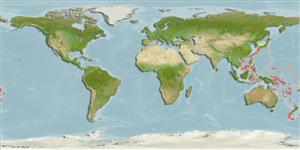Classification / Names
Common names from other countries
Main reference
Size / Weight / Age
Max length : 13.7 cm SL male/unsexed; (Ref. 31524)
Environment
Marine; bathydemersal; depth range 205 - 330 m (Ref. 34024)
Climate / Range
Deep-water, preferred ?
Distribution
Short description
Dorsal
soft rays
(total): 91-92;
Anal
soft rays: 76;
Vertebrae: 53 - 54. The ventral fins reach beyond the origin of anal fin. The hind margin of preoperculum has two spines. There are eleven (11) long rakers on the anterior gill arch. The anterior ocellus is at the origin of the dorsal fin, while the second and larger ocellus is posterior to the anus.
IUCN Red List Status (Ref. 115185)
Threat to humans
Harmless
Human uses
More information
Age/SizeGrowthLength-weightLength-lengthLength-frequenciesMorphometricsMorphologyLarvaeLarval dynamicsRecruitmentAbundance
ReferencesAquacultureAquaculture profileStrainsGeneticsAllele frequenciesHeritabilityDiseasesProcessingMass conversion
Tools
Special reports
Download XML
Internet sources
Estimates of some properties based on models
Phylogenetic diversity index
PD50 = 0.5000 many relatives (e.g. carps) 0.5 - 2.0 few relatives (e.g. lungfishes)
Trophic Level
3.4 ±0.58 se; Based on food items.
Resilience
Medium, minimum population doubling time 1.4 - 4.4 years (Assuming tmax>3)
Vulnerability
Low vulnerability (19 of 100)
Price category
